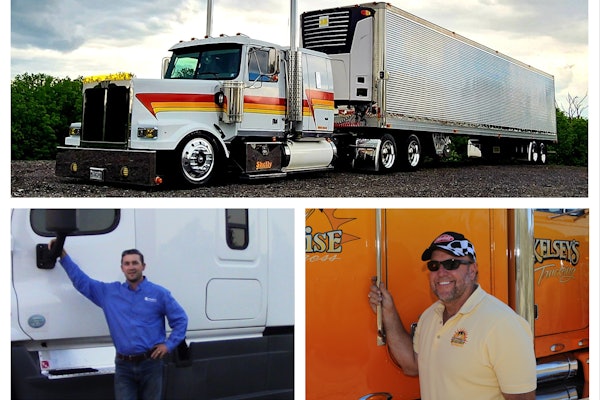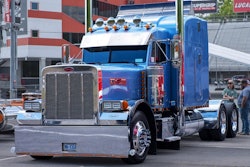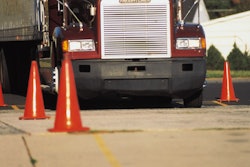HIGHWAY REPORT CARD
WORST ROADS
1. Arkansas
2. Pennsylvania
3. Louisiana
4. California
5. Illinois
BEST ROADS
1. Texas
2. Florida
3. Tennessee
4. Georgia
5. Ohio
MOST IMPROVED ROAD OVER THE PAST YEAR
1. I-40 Arkansas
2. I-30 Arkansas
3. I-80 Pennsylvania
4. I-80 Nebraska
5. I-10 Louisiana
WORST FOUR-WHEELERS
1. California
2. New York
3. Illinois
4. Florida
5. Texas
BEST FOUR-WHEELERS
1. Texas
2. Indiana
3. Montana
4. California
5. Missouri
TOUGHEST ON TRUCK INSPECTIONS AND LAW ENFORCEMENT
1. California
2. Ohio
3. Pennsylvania
4. Missouri
5. Tennessee
WEAKEST ON TRUCK INSPECTIONS AND LAW ENFORCEMENT
1. Alabama
2. Oklahoma
3. Texas
4. Mississippi
5. Nevada
LEAST AVAILABLE OVERNIGHT PARKING
1. California
2. New Jersey
3. Virginia
4. Connecticut
5. Illinois
MOST AVAILABLE OVERNIGHT PARKING
1. Texas
2. Indiana
3. Pennsylvania
4. Kentucky
5. Ohio
WORST REST STOPS
1. Texas
2. Arkansas
3. Ohio
4. New Jersey
5. New Mexico
BEST REST STOPS
1. Florida
2. Ohio
3. Indiana
4. Texas
5. Georgia
WORST TRUCK STOPS
1. New Jersey
2. New York
3. California
4. Massachusetts
5. Texas
BEST TRUCK STOPS
1. Texas
2. Iowa
3. Ohio
4. Nebraska
5. Georgia
The road to success has been long and rough for Arkansas. But four years into its five-year road reconstruction program, Arkansas is making progress that truckers are noticing. Two of the main stretches across Arkansas, I-40 and I-30, topped this year’s Most Improved list in Overdrive’s Highway Report Card. Unfortunately, Arkansas, which has been among the top five of the Worst Roads list for about a decade, still isn’t out of the woods. Overdrive readers chose the state as having the nation’s worst roads.

“This is the fourth year of our ambitious program, and everything is on schedule, and we are happy with the results and that it’s coming to an end,” says Glenn Bolick, public information officer for the Arkansas State Highway and Transportation Department. “We have probably done 15 or 20 years’ worth of work in five years. We’re a major crossroads. We had about 356 miles to repair, and we spent about $970 million over about 50 projects.”
Bill Taylor of Meriden, Conn., who is leased to Logistics Express out of Orange, Calif., is among those who appreciate Arkansas’ progress.
“My wife and I run team across 48 states and Canada,” he says. “I used to say that the worst roads were in Arkansas, but they have done a wonderful job on I-40.”
Archie Landis of Hartford, Ala., an independent owner-operator who has been driving for 26 years, voted for I-40 through Arkansas as being the most improved road. “We used to not get any sleep going through there, the way the roads were messed up,” he says. “And if everything wasn’t locked down, then it ended up on the floor.”
Another state frequently near the top of the Worst Roads category of the Highway Report Card is Louisiana, so it’s not surprising that the state ranked second this year.
“Louisiana roads are just rough,” says Dean Connot of Blossom, Texas, who has been driving for 10 years. “But they build wonderful bridges in Louisiana. Why can’t they build a road?”
Louisiana spends roughly $250 million preserving its roads and about $125 million on adding lanes and new bridges, says Tracy Horne, Louisiana Department of Transportation and Development public information officer. “There is a tremendous amount of truck traffic through the state, so when you have that kind of traffic, it does tremendous damage,” she says. “We’re always doing construction along the main roads. People want added capacity and better roads, but they don’t want the inconvenience.” All that money has paid off a little: I-10 through Louisiana was voted fifth Most Improved.
“Louisiana is getting better, but even in the hammer lane, you’ll get bumped out of the bed while the driver hangs on to the steering wheel,” say Pam and Cliff Dancy of Deer Lodge, Mont., who haul reefer loads across 48 states.
One highway hazard that is not getting better is road rage. Almost 60 percent of respondents think road rage has increased in the past year. And another 27 percent of truckers last year said they believe it’s as bad as it was in 2002.
“I’ve seen so many wrecks and people cutting each other off. People flip me off because I’m in their way,” Landis says. “I’ve seen cars fight for the same piece of highway. There’s no courtesy left out there anymore.”
Connot is one of those who’s convinced the problem has worsened. “You make someone mad just by changing lanes. You don’t have to do anything to earn it,” he says. “If you leave enough following space, someone just has to squeeze in there. Everybody’s in too big a hurry. It’s plain discourteousness.”
Road rage is a daily occurrence, says Randy Estes of Beattyville, Ky., a steel hauler who has been driving for about 16 years. “People cut you off,” he says. “People are in too big of a hurry.”
And where is the highest concentration of bad four-wheelers? Readers say California – though a smaller percentage also rank the state as fourth for the best four-wheelers.
“California car drivers don’t like big trucks,” say the Dancys, who are leased to Jim Palmer Trucking. “They don’t understand. It’s the road rage capital of the world. We realize there are a lot of cars, but the enforcement should lay off the trucks; trucks are usually going within 5 mph of the speed limit, but cars are guaranteed to be doing 10 or 20 mph above.”
Other respondents agree about the enforcement; California again topped the list of states with the toughest inspections and law enforcement. “In California, the inspections are just plain ridiculous,” Connot says.
The state also made it onto the top five for Worst Roads, Least Available Overnight Parking and Worst Truck Stops.
“Rest areas in California are full by 3 or 4 p.m., and rest areas are few and far between,” says Landis. “We usually stop somewhere in Arizona and wait until it’s time to go.” Landis and his wife Toni go to California every week hauling produce, poultry and dry goods.
Texas is another state that made quite a few lists on this year’s Highway Report Card – some good, some bad – including the No. 1 spots for Best Roads, Most Available Overnight Parking, Worst Rest Stops, Best Truck Stops and Best Four-wheelers. Texas also appears in one of the top spots for Best Rest Stops, Weakest Truck Inspections, Worst Four-wheelers and Worst Truck Stops.
“Texas has all those picnic areas that are gigantic. You can tell they’re making an effort to give parking to trucks,” says Landis.
“I seldom have trouble finding parking in Texas at all,” Connot says.
Jack Isham, who has been driving almost 50 years, doesn’t agree with the positive findings about parking in Texas.
“Texas is a huge state, and they have rinky-dinky rest areas that accommodate maybe eight or 10 trucks,” says the Rockford, Ill., owner-operator who is leased to Roadrunner Freight Systems and hauls less-than-truckload. “Why even waste your time?”
“I don’t care for Texas rest areas. There’s no privacy because it’s so open,” Estes says.
A state with a clear parking problem is the Garden State. It was voted first for Worst Truck Stops, second for Least Available Overnight Parking and fourth for Worst Rest Stops.
“New Jersey has the worst truck stops. They’re crowded and cramped,” Estes says.
“That’s because we hardly have any,” says Gail Toth, executive director for the New Jersey Motor Trucks Association. “Truckers have to park on the side of the road. The Turnpike is overloaded, but they did just add some spaces, and they’re trying to develop truck-only rest areas. It’s very hard to find space to build truck stops because property is so expensive. We generate tremendous truck traffic. They wait in New Jersey for the sun to come up before they go to New York City.”
Turnpike officials have tried to make the highway a better option for truckers. Fuel is priced cheaper. Officials have been expanding parking slots, and they’re offering truckers more personalized services by adding and upgrading facilities.
“I worry about these guys that have to park on the side of the road,” Toth says. “If we are going to depend so much on trucking, our drivers need to be safe. They are in desperate need of sleep, and with the new hours of service, it will only get worse. We need places to put them, and even though the public has a negative perception of truckers, their safety should supersede any concerns the public has.”
One state that has consistently overcome parking problems is Florida. The state tops the Best Rest Stops list – for the fourth time in a row.
“We keep track of the conditions through a good comment card system,” says engineer Dave Anderson of the Florida Department of Transportation. “We spend about $22 million a year to maintain the rest areas, which includes armed guards from 3 in the afternoon until 8 in the morning and 24-hour attendants.”
The state has 82 rest areas, which includes 16 truck comfort stations, as well as eight turnpike service plazas. “We set the standards for all the districts to follow for rest areas,” Anderson says.













